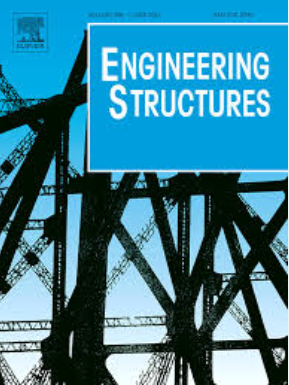3D打印实现UHPFRC复合材料梁的成本效益设计:纤维分布和取向对弯曲性能和失效模式转变的影响
IF 6.4
1区 工程技术
Q1 ENGINEERING, CIVIL
引用次数: 0
摘要
为了降低超高性能纤维增强混凝土(UHPFRC)结构的高成本,本研究提出了一种新型的UHPFRC复合梁设计和一种优化纤维取向和分布的3D打印-铸造混合制造方法。具体来说,UHPFRC仅在拉应力临界区域(如下弯曲和斜剪)进行3d打印(3d -UHPFRC),纤维沿主拉应力方向排列,以提供最佳的裂缝约束和桥接效果,而无纤维UHPC则在其他地方浇铸。考虑制作工艺、3D - uhpfrc层厚和剪切钢筋3个参数,对12根梁进行四点弯曲试验,借助于数字图像相关(DIC)观察表面裂纹扩展情况,并利用微x射线计算机断层扫描(μXCT)表征打印层间界面和打印-铸造界面周围的内部三维微观结构。与纤维体积分数为1.5 %的铸梁相比,在相同的极限荷载下,复合梁的纤维最大减少量为53 %,在相同的名义开裂荷载下,纤维最大减少量为72 %,相应的材料成本分别降低了24 %和33 %。DIC分析表明,在斜角剪切区域,3d打印纤维将梁的破坏模式从脆性剪切转变为韧性弯曲,尽管纤维节约量减少到35% %。3D μXCT图像表明,3D打印能够使大部分纤维沿打印方向排列,并且不会明显导致界面附近孔隙的增加,因此对梁的结构行为几乎没有影响。本文章由计算机程序翻译,如有差异,请以英文原文为准。
3D printing towards cost-effective design of composite UHPFRC beams: Effects of fiber distribution and orientation on flexural performances and failure mode transition
To reduce the high cost of ultra-high-performance fiber-reinforced concrete (UHPFRC) structures, this study proposes a novel composite UHPFRC beam design and a 3D printing–casting mixed fabrication method with optimal fiber orientation and distribution. Specifically, the UHPFRC is 3D-printed (3DP-UHPFRC) only in tensile stress-critical regions such as lower bending and diagonal shear, with the fibers aligned along the principal tensile stress direction to provide optimal crack constraining and bridging effects, while the fiber-free UHPC is cast elsewhere. Four-point bending tests of 12 beams considering 3 parameters, namely fabrication process, 3DP-UHPFRC layer thickness, and shear reinforcement were carried out, assisted by digital image correlation (DIC) to observe surface crack propagation and micro X-ray computed tomography (μXCT) to characterize the internal 3D microstructures around the printed interlayer interfaces and print-cast interfaces. Compared with the cast beam with a fiber volume fraction of 1.5 %, the composite beams achieved a maximum fiber reduction of 53 % for the same ultimate load and 72 % for the same nominal cracking load, with corresponding material cost reductions of 24 % and 33 %. The DIC analyses showed that 3D-printing fibers in the diagonal shear regions shifted the beam failure mode from brittle shear to ductile flexure, though the fiber saving was reduced to 35 %. The 3D μXCT images indicated that 3D printing was able to force most of the fibers to align along the printing direction and did not evidently result in more pores near the interfaces, thus hardly affecting the beam structural behavior.
求助全文
通过发布文献求助,成功后即可免费获取论文全文。
去求助
来源期刊

Engineering Structures
工程技术-工程:土木
CiteScore
10.20
自引率
14.50%
发文量
1385
审稿时长
67 days
期刊介绍:
Engineering Structures provides a forum for a broad blend of scientific and technical papers to reflect the evolving needs of the structural engineering and structural mechanics communities. Particularly welcome are contributions dealing with applications of structural engineering and mechanics principles in all areas of technology. The journal aspires to a broad and integrated coverage of the effects of dynamic loadings and of the modelling techniques whereby the structural response to these loadings may be computed.
The scope of Engineering Structures encompasses, but is not restricted to, the following areas: infrastructure engineering; earthquake engineering; structure-fluid-soil interaction; wind engineering; fire engineering; blast engineering; structural reliability/stability; life assessment/integrity; structural health monitoring; multi-hazard engineering; structural dynamics; optimization; expert systems; experimental modelling; performance-based design; multiscale analysis; value engineering.
Topics of interest include: tall buildings; innovative structures; environmentally responsive structures; bridges; stadiums; commercial and public buildings; transmission towers; television and telecommunication masts; foldable structures; cooling towers; plates and shells; suspension structures; protective structures; smart structures; nuclear reactors; dams; pressure vessels; pipelines; tunnels.
Engineering Structures also publishes review articles, short communications and discussions, book reviews, and a diary on international events related to any aspect of structural engineering.
 求助内容:
求助内容: 应助结果提醒方式:
应助结果提醒方式:


